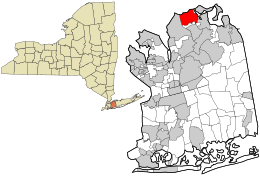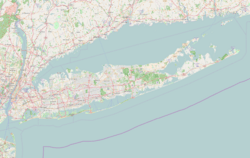Lattingtown, New York facts for kids
Quick facts for kids
Lattingtown, New York
|
|
|---|---|
| Incorporated Village of Lattingtown | |

The Bailey Arboretum in Lattingtown in 2018.
|
|

Location in Nassau County and the state of New York.
|
|
| Country | |
| State | |
| County | Nassau |
| Town | Oyster Bay |
| Incorporated | 1931 |
| Named for | The Latting family |
| Area | |
| • Total | 3.82 sq mi (9.90 km2) |
| • Land | 3.75 sq mi (9.71 km2) |
| • Water | 0.08 sq mi (0.20 km2) |
| Elevation | 62 ft (19 m) |
| Population
(2020)
|
|
| • Total | 1,881 |
| • Density | 502.00/sq mi (193.82/km2) |
| Time zone | UTC-5 (Eastern (EST)) |
| • Summer (DST) | UTC-4 (EDT) |
| ZIP code |
11560
|
| Area codes | 516, 363 |
| FIPS code | 36-41432 |
| GNIS feature ID | 0955075 |
Lattingtown is a small village located in Nassau County, on Long Island, in New York. It is part of the Town of Oyster Bay. In 2020, about 1,881 people lived there.
Contents
History of Lattingtown
The area where Lattingtown is now was once home to a group of Native Americans called the Lenape, specifically a band known as the Matinecock.
In 1660, the Matinecock sold this land to Richard Latting and his son, Josiah Latting. The Latting family was known for selling marsh reeds, which were used to make roofs for houses back then. The village was later named after this family.
Lattingtown officially became an independent village in 1931.
A well-known movie called The Money Pit was partly filmed in Lattingtown in 1986.
Geography of Lattingtown
Lattingtown covers an area of about 3.8 square miles (9.9 square kilometers). Most of this area is land, with a small part being water.
Population and People
| Historical population | |||
|---|---|---|---|
| Census | Pop. | %± | |
| 1940 | 613 | — | |
| 1950 | 745 | 21.5% | |
| 1960 | 1,461 | 96.1% | |
| 1970 | 1,773 | 21.4% | |
| 1980 | 1,749 | −1.4% | |
| 1990 | 1,859 | 6.3% | |
| 2000 | 1,860 | 0.1% | |
| 2010 | 1,739 | −6.5% | |
| 2020 | 1,881 | 8.2% | |
| U.S. Decennial Census | |||
The population of Lattingtown has changed over the years. In 2000, there were 1,860 people living in the village. By 2020, the population had grown slightly to 1,881.
In 2000, about 26% of the people living in Lattingtown were under 18 years old. The average age of residents was 42 years. Most households were made up of married couples.
Places to Visit
- Bailey Arboretum: This is a beautiful garden and nature preserve named after Frank and Marie Louise Bailey, who lived in the area for a long time.
- Underhill Burying Ground: This is a historic family cemetery belonging to the Underhill family.
See also
 In Spanish: Lattingtown para niños
In Spanish: Lattingtown para niños



